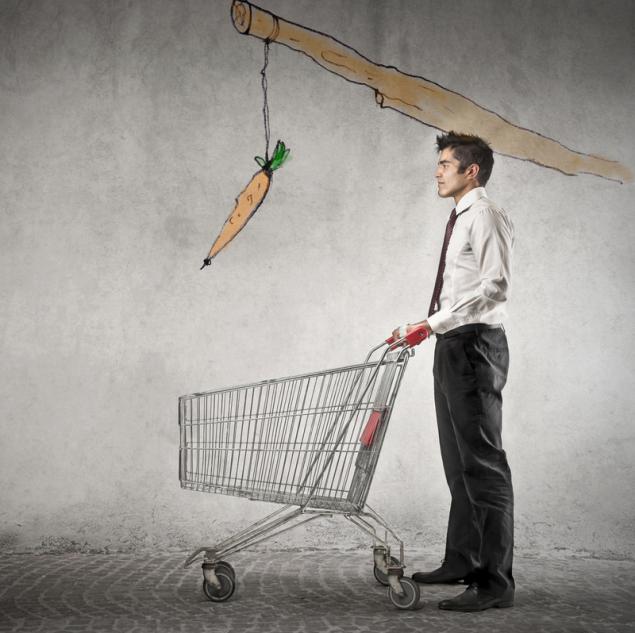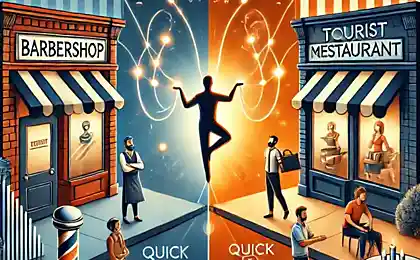592
How not to buy too much: 10 psychological above seasoned marketers
Have you ever wondered why, again bought on sale "for half the price" regular "gown with pearl buttons" that will never wear? Or why you have to spend half on a new version of the smartphone, "as people", although you actually more comfortable with the old?
Today on traces of publications for professional marketers we share with you ten marketing "hooks" to which we again and again fall into the ocean of the consumer market.

1. Priming effect (priming)
Have you ever played a game where one person says a word, and the other immediately responds with the first Association that comes to mind? Popular games such as, for example, Elias (Alias). As a rule, unmistakable works the consistent associations such as: "Tula ..." gingerbread, "the latest ..." call.
It's kind of like programming. You get one signal, and it affects how you respond to the subsequent signal. The magazine Psychology Today cites a study of two groups of people reading sequentially the words "yellow" and then either "sky" or "banana". Because people have a semantic relationship between the fruit and its color, a group of "yellow banana" will recognize the word "banana" faster than a group of "yellow sky" recognizes "heaven".
As it applies to marketing? For example, using this method to select the background of the website, you can help website visitors to remember key information about the brand — and perhaps even influence their buying behavior.
It was previously tested. In a study conducted by Naomi Mandel and Eric Johnson, the scientists changed the background and design of the web site to see how this could affect the choice of product by consumers. Participants were asked to choose one of two products of the same category (for example, between Toyota and Lexus). The researchers found:
"... the visitors that have been programmed for the money (in the background of the website was green and depicts dollars), watched the price information longer than those who were programmed for safety (the background was red-orange in color with a picture of a flame). Similarly consumers who have been programmed on comfort when choosing a sofa, looking longer information about the comfort of the sofa (site was done in blue colour with the image of light clouds) than those who would be programmed for the money (green background with dollars)".
2. Reciprocity
In the book Dr. Robert Cialdini "Influence: the Psychology of persuasion" (Influence: The Psychology of Persuasion), the concept of "reciprocity" presented an extremely simple formula — if someone does something for you, you naturally will want to do something in response to him.
If you ever got chewing gum along with your bill in a cafe or restaurant, you've been a victim of reciprocity. According to Cialdini, when waiters bring the check to the visitor without chewing gum, it will certainly affect the size of the tip as a reflection of the perception of service quality. With one chewing gum tips increased by 3.3%. Two mint? The tip can increase up to 20%!
In marketing there are many ways to take advantage of reciprocity. The seller does not have to be ruined, giving you a free valuable things. The bonus can be anything from branded t-shirts to exclusive ebooks, free Wallpapers for desktop, or a collection of tips on some issue. Even something as simple as a handwritten card or note can be the key to establishing reciprocity. The seller is enough to give free and probably unnecessary thing to you, before you request something more tangible in return.
3. Social influence
Most are already familiar with this concept, but it is too important to be left unattended. If you are not familiar with it, then according to the concept of informational social influence (or social proof, social proof) people tend to adopt the beliefs or actions of a group of people whom they love or whom they trust. In other words, it's "me too"effect. Or the effect of the "dance floor" — few want to be first on the dance floor when the dance is just beginning, but as soon as the first few people start dancing, others join in.
The simplest way to use social influence is social buttons under blog posts and websites. The number of the census speaks for itself, forcing a new reader to do the same, and the presence of friends in the readers of the page or blog creates an overwhelming desire "to join."

4. The effect of bait
Most often this effect is used in the pricing model – one price is included deliberately to encourage you to choose the most expensive option.
In the famous TED talk of Dan Arlie "Do we have control of our own decisions?" (Dan Arley "Are we in control of our own decisions?") he cites the example of the announcement of magazine The Economist outlining the options packages subscription to this magazine. Here's what they suggested:
Crazy, isn't it? You can only get a printed version of the magazine and package online+printed version for the same price. Why do they propose it?
This question was asked and Dan Arlie, but turning to The Economist, he certainly did not get a straight answer.
So he decided to conduct their own research with the participation of a hundred students. He gave them the price packages described above, and asked what they would like to buy. When the students were voiced by all three options, the students chose a combination of subscription — it was the best offer, isn't it? But when he ruled out "meaningless" option (subscription to the print edition for $ 125), students preferred the cheapest option.
It turned out that the middle option was not so useless – it gave students the start of the countdown in order to evaluate how "good" were combined option and urged them to pay more for this option.
So to achieve its goal, the seller can add to two main options a third option, thereby increasing the chances of acquisition of goods, the sale of which is interested first of all he is...
5. Limitirovanie
Have you ever shopped on the website, the plane tickets or booked the hotel and saw the warning "only 3 seats at this price"? Yes, this is the deficit (another concept that uses Dr. Cialdini). This psychology principle goes back to the simple formula of supply and demand: the more rare is the opportunity, content or product, the more valuable they are.
In 1975, Stephen Worchel, Jerry Lee and Akanbi Adewole conducted a study to see how the deficit affects our perception. They asked people to rate chocolate chip cookies. One jar had ten pieces of cookies, and the other only two.
"Rating cookies from the jar in which there were only two, was two times more than the rating of the cookies from the other banks. The effect was maintained and provided that the biscuits in the banks was the same."
Therefore, when advertising is replete with the words "exclusive", "limited edition" or "final offer", ask yourself what attracts you more – the product or your exclusive owner.
6. The effect of the armature
Have you ever wondered why is it so hard to resist the sales at your favorite clothing store?
Often this is due to the effect of anchor — people make decisions based on the information they receive. So what if my favorite store usually sells jeans for $ 50, but the sale gives for $ 35, I'll be delighted. I'll think, "I get crazy discount on these jeans!" And, most likely, will buy them. But if my friend usually buys jeans for $ 20, then this discount will not be quite so impressive.
The effect of anchors is the most important course for marketers: they should clearly set the anchor — point of the initial sale price, and then specify the actual price and the next specify the percentage of savings (preferably bright and catchy).
7. The phenomenon of Baader-Meinhof, or frequency illusion
Has it ever happened with you that after hearing for the first time about something, then you start to see it everywhere in everyday life? For this you can thank the phenomenon of Baader-Meinhof. Similar starts to happen after you are faced with something the first time, and then you start to notice the appearance around you. Suddenly you see an ad for that product every time you watch TV. And when you go to the store, walking along the counter, then randomly find the same thing. And have ALL your friends already have this product.
Strange, isn't it? This phenomenon, which is also called the frequency illusion, is caused by two processes:
"First, selective attention kicks in when you are striking a new word, thing, or idea. After that, you unconsciously keep an eye on that site and in a result find it surprisingly often. Secondly, the proof that convinces you that each new appearance of a product in your life is another proof of your impression that the thing has gained overnight omnipresence".
For marketers, this phenomenon is extremely important. Once you begin to notice their brand, they want to help you see it "everywhere". And begin to send you targeted e-mails, to issue targeted advertising to enable you to ensure that you will not be able to escape from their unobtrusive attention...

8. Verbal effect
According to a study conducted by a group of scientists of the University on, people are more likely to remember the gist of what someone said, rather than specific details. So when you attend training on how to blog better for your business, you're more likely to remember details such as "Send your article to someone to edit before publication" and not "Send Google Doc for three days before publication to colleagues, so they can make edits to your work. Don't forget to make changes in "edit mode" to know what you missed!".
Scientists called this the "literal effect", and it can have a huge impact on what is perceived as content. It is known that people spend a small amount of time reading online and on some sites they do not stay more than 15 seconds.
Therefore, the focus of marketers give a short and catchy title. If the title clearly reflects the content of the article, then you are much faster remember its essence, and later easily recall its name again to find it in Google.
9. Clustering (grouping)
People have limited space in short-term memory. Most of us can only remember seven units of information at the same time (plus or minus two chunks in a given situation).
To cope with this problem, most people have a tendency to group similar pieces of information together. For example, if you had a whole shopping list of random items, then you strive mentally to group line items in certain categories (dairy products, meat, etc.), to be able better to recall that it was on the list.
Why marketers pay so much attention to the clustering of content. Grouping similar subjects together under a numbered list or with different sizes of header — allows us to better remember information.
10. "Aversion to loss" (Loss aversion)
Avoidance of losses, or "aversion to loss", means that after you have something there, you sooooo don't want to lose something.
When Daniel Kahneman studied this concept, study participants were given a mug, the chocolate or do nothing. Participants were then asked to make a choice: if they got something, they could trade them, but if they got nothing, they can choose one of two options objects.
What was the result? Approximately half of the participants who started without any items, chose the mug, but 86% of people who received the mugs from the beginning "stuck" with them, not wanting to sell them.
Morality? People don't like to lose what they already have.
Also interesting: How marketers are using Your systems
Why we buy: how marketers manipulate our minds
This effect has been successfully used by marketers. For example, the provision of free versions of IT product for a specified period of time. After the free usage has expired, the app can be deleted if the buyer does not pay for continued use.published
Source: monocler.ru/10-priemov-marketologov/
Today on traces of publications for professional marketers we share with you ten marketing "hooks" to which we again and again fall into the ocean of the consumer market.

1. Priming effect (priming)
Have you ever played a game where one person says a word, and the other immediately responds with the first Association that comes to mind? Popular games such as, for example, Elias (Alias). As a rule, unmistakable works the consistent associations such as: "Tula ..." gingerbread, "the latest ..." call.
It's kind of like programming. You get one signal, and it affects how you respond to the subsequent signal. The magazine Psychology Today cites a study of two groups of people reading sequentially the words "yellow" and then either "sky" or "banana". Because people have a semantic relationship between the fruit and its color, a group of "yellow banana" will recognize the word "banana" faster than a group of "yellow sky" recognizes "heaven".
As it applies to marketing? For example, using this method to select the background of the website, you can help website visitors to remember key information about the brand — and perhaps even influence their buying behavior.
It was previously tested. In a study conducted by Naomi Mandel and Eric Johnson, the scientists changed the background and design of the web site to see how this could affect the choice of product by consumers. Participants were asked to choose one of two products of the same category (for example, between Toyota and Lexus). The researchers found:
"... the visitors that have been programmed for the money (in the background of the website was green and depicts dollars), watched the price information longer than those who were programmed for safety (the background was red-orange in color with a picture of a flame). Similarly consumers who have been programmed on comfort when choosing a sofa, looking longer information about the comfort of the sofa (site was done in blue colour with the image of light clouds) than those who would be programmed for the money (green background with dollars)".
2. Reciprocity
In the book Dr. Robert Cialdini "Influence: the Psychology of persuasion" (Influence: The Psychology of Persuasion), the concept of "reciprocity" presented an extremely simple formula — if someone does something for you, you naturally will want to do something in response to him.
If you ever got chewing gum along with your bill in a cafe or restaurant, you've been a victim of reciprocity. According to Cialdini, when waiters bring the check to the visitor without chewing gum, it will certainly affect the size of the tip as a reflection of the perception of service quality. With one chewing gum tips increased by 3.3%. Two mint? The tip can increase up to 20%!
In marketing there are many ways to take advantage of reciprocity. The seller does not have to be ruined, giving you a free valuable things. The bonus can be anything from branded t-shirts to exclusive ebooks, free Wallpapers for desktop, or a collection of tips on some issue. Even something as simple as a handwritten card or note can be the key to establishing reciprocity. The seller is enough to give free and probably unnecessary thing to you, before you request something more tangible in return.
3. Social influence
Most are already familiar with this concept, but it is too important to be left unattended. If you are not familiar with it, then according to the concept of informational social influence (or social proof, social proof) people tend to adopt the beliefs or actions of a group of people whom they love or whom they trust. In other words, it's "me too"effect. Or the effect of the "dance floor" — few want to be first on the dance floor when the dance is just beginning, but as soon as the first few people start dancing, others join in.
The simplest way to use social influence is social buttons under blog posts and websites. The number of the census speaks for itself, forcing a new reader to do the same, and the presence of friends in the readers of the page or blog creates an overwhelming desire "to join."

4. The effect of bait
Most often this effect is used in the pricing model – one price is included deliberately to encourage you to choose the most expensive option.
In the famous TED talk of Dan Arlie "Do we have control of our own decisions?" (Dan Arley "Are we in control of our own decisions?") he cites the example of the announcement of magazine The Economist outlining the options packages subscription to this magazine. Here's what they suggested:
- Online subscription: $ 59
- Subscription for printed edition: $ 125
- Online subscriptions and print subscriptions: $ 125
Crazy, isn't it? You can only get a printed version of the magazine and package online+printed version for the same price. Why do they propose it?
This question was asked and Dan Arlie, but turning to The Economist, he certainly did not get a straight answer.
So he decided to conduct their own research with the participation of a hundred students. He gave them the price packages described above, and asked what they would like to buy. When the students were voiced by all three options, the students chose a combination of subscription — it was the best offer, isn't it? But when he ruled out "meaningless" option (subscription to the print edition for $ 125), students preferred the cheapest option.
It turned out that the middle option was not so useless – it gave students the start of the countdown in order to evaluate how "good" were combined option and urged them to pay more for this option.
So to achieve its goal, the seller can add to two main options a third option, thereby increasing the chances of acquisition of goods, the sale of which is interested first of all he is...
5. Limitirovanie
Have you ever shopped on the website, the plane tickets or booked the hotel and saw the warning "only 3 seats at this price"? Yes, this is the deficit (another concept that uses Dr. Cialdini). This psychology principle goes back to the simple formula of supply and demand: the more rare is the opportunity, content or product, the more valuable they are.
In 1975, Stephen Worchel, Jerry Lee and Akanbi Adewole conducted a study to see how the deficit affects our perception. They asked people to rate chocolate chip cookies. One jar had ten pieces of cookies, and the other only two.
"Rating cookies from the jar in which there were only two, was two times more than the rating of the cookies from the other banks. The effect was maintained and provided that the biscuits in the banks was the same."
Therefore, when advertising is replete with the words "exclusive", "limited edition" or "final offer", ask yourself what attracts you more – the product or your exclusive owner.
6. The effect of the armature
Have you ever wondered why is it so hard to resist the sales at your favorite clothing store?
Often this is due to the effect of anchor — people make decisions based on the information they receive. So what if my favorite store usually sells jeans for $ 50, but the sale gives for $ 35, I'll be delighted. I'll think, "I get crazy discount on these jeans!" And, most likely, will buy them. But if my friend usually buys jeans for $ 20, then this discount will not be quite so impressive.
The effect of anchors is the most important course for marketers: they should clearly set the anchor — point of the initial sale price, and then specify the actual price and the next specify the percentage of savings (preferably bright and catchy).
7. The phenomenon of Baader-Meinhof, or frequency illusion
Has it ever happened with you that after hearing for the first time about something, then you start to see it everywhere in everyday life? For this you can thank the phenomenon of Baader-Meinhof. Similar starts to happen after you are faced with something the first time, and then you start to notice the appearance around you. Suddenly you see an ad for that product every time you watch TV. And when you go to the store, walking along the counter, then randomly find the same thing. And have ALL your friends already have this product.
Strange, isn't it? This phenomenon, which is also called the frequency illusion, is caused by two processes:
"First, selective attention kicks in when you are striking a new word, thing, or idea. After that, you unconsciously keep an eye on that site and in a result find it surprisingly often. Secondly, the proof that convinces you that each new appearance of a product in your life is another proof of your impression that the thing has gained overnight omnipresence".
For marketers, this phenomenon is extremely important. Once you begin to notice their brand, they want to help you see it "everywhere". And begin to send you targeted e-mails, to issue targeted advertising to enable you to ensure that you will not be able to escape from their unobtrusive attention...

8. Verbal effect
According to a study conducted by a group of scientists of the University on, people are more likely to remember the gist of what someone said, rather than specific details. So when you attend training on how to blog better for your business, you're more likely to remember details such as "Send your article to someone to edit before publication" and not "Send Google Doc for three days before publication to colleagues, so they can make edits to your work. Don't forget to make changes in "edit mode" to know what you missed!".
Scientists called this the "literal effect", and it can have a huge impact on what is perceived as content. It is known that people spend a small amount of time reading online and on some sites they do not stay more than 15 seconds.
Therefore, the focus of marketers give a short and catchy title. If the title clearly reflects the content of the article, then you are much faster remember its essence, and later easily recall its name again to find it in Google.
9. Clustering (grouping)
People have limited space in short-term memory. Most of us can only remember seven units of information at the same time (plus or minus two chunks in a given situation).
To cope with this problem, most people have a tendency to group similar pieces of information together. For example, if you had a whole shopping list of random items, then you strive mentally to group line items in certain categories (dairy products, meat, etc.), to be able better to recall that it was on the list.
Why marketers pay so much attention to the clustering of content. Grouping similar subjects together under a numbered list or with different sizes of header — allows us to better remember information.
10. "Aversion to loss" (Loss aversion)
Avoidance of losses, or "aversion to loss", means that after you have something there, you sooooo don't want to lose something.
When Daniel Kahneman studied this concept, study participants were given a mug, the chocolate or do nothing. Participants were then asked to make a choice: if they got something, they could trade them, but if they got nothing, they can choose one of two options objects.
What was the result? Approximately half of the participants who started without any items, chose the mug, but 86% of people who received the mugs from the beginning "stuck" with them, not wanting to sell them.
Morality? People don't like to lose what they already have.
Also interesting: How marketers are using Your systems
Why we buy: how marketers manipulate our minds
This effect has been successfully used by marketers. For example, the provision of free versions of IT product for a specified period of time. After the free usage has expired, the app can be deleted if the buyer does not pay for continued use.published
Source: monocler.ru/10-priemov-marketologov/























